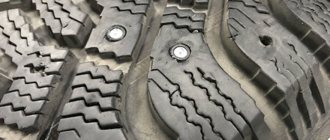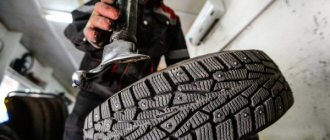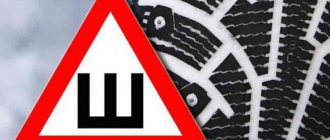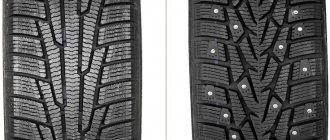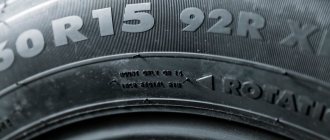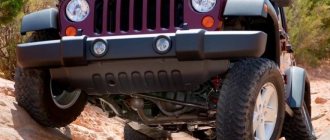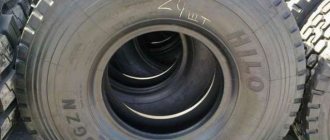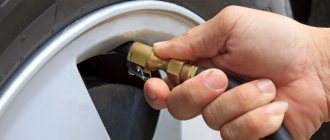Currently, motorists constantly return to such an issue as re-studding or repair studding of winter tires. This process has a huge number of supporters and detractors.
Wheel tire studding
On some aspects of studding winter tires with studs of various shapes and quality, one can find very contradictory reviews. Many motorists believe that studs on their tires are necessary in order to get out of any snow drift and in order to feel confident and safe on icy roads.
However, there are people who advise you to think carefully about whether it is worth making winter tires yourself, since this complex process depends not only on purchasing a high-quality stud gun. If you do not have enough experience and qualifications, then after poor-quality tucking you can end up with a rather noisy tire that wears out many times faster.
What is winter tire studding?
Tire tucking procedure
Studring winter tires is a very simple procedure, which consists of installing main or additional studs of various shapes into a new or used tire.
This procedure is carried out with minimal experience and qualifications, as well as with the presence of an air gun to carry out the studding procedure.
Winter tire
If the motorist cannot do anything on his own, he should contact the nearest tire service station. The fact is that it is the specialists of this service that will be able to provide a guarantee for the procedure performed.
You can carry out the initial starting procedure for studding the tire, but it is quite possible to carry out repair or re-studding if the studs fall out of the tire during operation.
Such tires will not last long, however, if it is not possible to purchase new brand tires, studding or studding will be an ideal option.
Basic requirements for studding tires at service stations
Tying tires is a standard procedure. It requires from a specialist not only the ability to use an air pistol.
He must also know what type of products to recommend to his client for safe use. In addition, it is very important for the driver to comply with the list of technological requirements for his new studded tires in order to ensure that their service life is as long as possible.
In particular:
- Before purchasing one or another type of studs for your tire, the vehicle owner should consult with a professional, telling him about the nature of the car's operation, the average speed of its movement, as well as the driving style. A service station employee will always offer the most optimal option. Key criteria also include rubber characteristics, namely tread depth, material softness, presence of sipes, etc.
- Depending on the thickness of the sole, the optimal length of the spike is selected. According to technology, it should not stick out from the tread by more than 1-1.3 mm.
- To determine the number of studs, the driver should know the size of his wheel, since for R13 experts recommend installing up to 80-90 studs, R14 - 90-100 pcs., R15 - 100-110 pcs., R16 - 130-150 pcs. With increasing dimension, the number of metal products on the protectors also increases proportionally.
You may be interested in this About winter tires for Niva
Tire studs
- If the driver does not have time to get the tires studded before the onset of cold weather, he should purchase ready-made studded tires, since after the procedure the rubber continues to move around each stud for several months, gradually compressing it. After studding, the tire should be stored at rest for about 3 months.
- After installing the studded wheels, the driver should run it for about 500 km in a quiet mode so that the flanges are tightly secured in the lamellas.
Important!
If the driver neglects the recommendations listed above, he should be prepared for the fact that already next season he will install repair studs for winter tires to replace the worn-out products.
Stages of the winter tire tucking procedure
Tire tucking procedure
The procedure for studding winter tires occurs in several mandatory stages, the start of which will be the purchase of a tire that:
- refers to the winter season;
- has increased rigidity;
- has no scuffs in the tread, and ideally be new;
- has special holes for spikes.
In addition to a set of winter tires, you should purchase high-quality tire studs, as well as an air gun. Studs for winter tires can be of several options:
- made of plastic or steel;
- round or oval, diamond or tetrahedral shape;
- two or single flange;
- with a tubular or rod core.
Tires with studs
It is worth choosing studs according to your driving style or the speed at which the driver drives the car. In order for studding to be successful, you should not only purchase a high-quality gun for studding tires and prepare:
- ninety studs for wheels with a diameter of 13 inches;
- one hundred and ten for a diameter of fourteen or fifteen inches;
- one hundred and fifty for a diameter of sixteen inches.
In this case, re-studding or re-studding is carried out before the start of winter and it is necessary to break in the tire after it. It is worth fixing it before performing the procedure, and then lubricating the surface with thick soap foam.
Repair studs for tires
This is done so that the studs from the air gun fit better into the tire. Distortions and unreliable fit of the stud in the tire must not be allowed. If the spike is inserted incorrectly, its position can be adjusted until the foam dries completely.
After the procedure is successful, you should let the rubber sit for three days, but you should not return the ejected spikes to their place, since the hole has already been deformed.
How to make studding
For studding, you can choose all-season tires, in which a specialist will cut holes for the studs. For these purposes, a special hollow tool and profile equipment are used, rather than a conventional drill and drill. As a result, the holes for the tenons are identical to each other in depth and diameter, and also have smooth edges and inner walls, without tears or burrs.
Next, spikes are inserted into the holes using a pneumatic gun. Please note: this can be done without damaging the rubber only under pressure and using a wetting solution. After the lubricant dries, a strong connection between the part and the tread is obtained.
Drilling holes in the tire and installing studs in the factory
"AvtoOshipovka Tekom" has been studding all types of tires since 1995 and offers:
- certified stitching on machines;
- production of holes in the tread using patented technology;
- servicing individuals and businesses;
- a wide range of spikes for various purposes.
Drilling holes with a conventional drill is a gross violation of technology: incorrect installation of studs will lead to accelerated damage to the rubber and loss of studs.
We design studs and test the developed products. We take into account the individual wishes of clients, as well as the unique sports orientation of orders. If there is no choice of ready-made studded tires of your size on sale, this is not a reason to deprive yourself of the opportunity to comfortably and safely operate your car in bad weather conditions.
Good day! I'm interested in the opinion and experience of a respected community on the issue of studding all-season tires - whether it's worth the bother or not. And if so, which spikes are better so that they don’t fly out very quickly.
All last winter I rode the Federal Couragia MT 235/85 R16, which is positioned by the manufacturer as all-season (M+S) - tolerable if you don’t race, but on ice there’s no way at all, you can’t really accelerate or brake, like on a sled. About the same as the studless Bridgestone Blizzak DM VI. It is clear that normal winter studded tires are best, but I would like to consider all options. Thanks in advance for your answers!
PS: photo from the Internet.
Advantages and disadvantages of studding
Re-studding winter tires is a revolutionary way to preserve tires, according to reviews from numerous motorists. The fact is that in this case it is worth using repair spikes, which attract attention with a large head.
Studded tire
At the same time, studded winter tires have a number of advantages:
- provides increased controllability;
- improves the quality of traction on problematic road surfaces;
- shortens the distance when braking;
- provides excellent cornering;
- eliminates slipping at start;
- Ideal for those who constantly navigate icy roads.
Winter tire
At the same time, for those motorists who move within the city, the studs become useless. But the negative aspects of this procedure include:
- increased noise and vibration;
- decreased comfort;
- premature wear if the tires are used on asphalt;
- decreased smoothness;
- impossibility of damping various vibrations.
How is everything going?
The tread is carefully inspected, if necessary, worn out studs are removed and a new repair stud is pressed into their place using a special pneumatic gun. The entire operation does not require beading of the tire and takes a minimum of time, returning the original characteristics of the retreaded tire. To save time, it can be combined with seasonal tire fitting.
All you have to do is:
- Plan a trip;
- Call and make an appointment at a time convenient for you at any Bus center - 33;
- Arrive at the appointed time and we will get to work without delay.
Call +7
Is it worth doing the stitching yourself?
On the Internet you can actually find a video showing how to perform initial or repeated studding of tires with your own hands. That is why it is worth deciding in advance whether it is worth doing this procedure yourself, and also deciding on the choice of components, including winter tires, studs and a pneumatic stud gun.
At the same time, studding of a winter tire can be carried out with various studs, none of which are ideal. The fact is that new designs and design features for winter tire studs are constantly appearing on the automotive market.
At the same time, it is up to the individual motorist to decide whether to carry out studding on his own or turn to professionals for tire fitting, based on his own experience, since if the procedure is incorrect, he will have to purchase other winter tires.
What to do?
There is an exit. At our tire center we offer a new service - re-studding with a repair stud. A repair stud is a stud with a bushing size that is larger than the standard one and a flange made of wear-resistant polymer. Due to the increased diameter of the flange, the stud is securely attached to the mounting hole, and wear of the rubber does not matter much.
The main working element is a carbide insert based on tungsten carbide, which fully corresponds to a standard stud, and its resource lasts until the tread is completely worn out.
Tire addition: choice of studs
The best option would be products made from iron-containing alloys; they are not subject to deformation and remain intact even after driving on a dirt road with many potholes and bumps. The shape of the tip can be different; the round version is quite common due to its attractive cost, but it has low efficiency. Residents of northern regions with harsh climates should pay attention to multifaceted studs that confidently hold the car even on bare ice.
There are also diamond spikes, which get their name due to their crystalline multifaceted structure. Adding tires with such products provides reliable grip on the road, but they are subject to rapid wear. Tetrahedral, cruciform and triangular elements have similar properties.
Based on the number of flanges, products are divided into two types. Single-flange cleats are low cost and have minimal impact on the seat, but they provide low ride efficiency. Double flanged parts are ideal for high speed and maneuvering.
View gallery
How it's done
The secondary stud technology is quite simple:
- The holes are cleaned, removing fragments of old thorns and dirt.
- The tire is moistened with a soapy solution to promote a smooth fit.
- Select the optimal diameter of the repair material, similar to the size of the original tenon.
- The spikes are inserted into the sockets using the instrumental method (using a special gun) under pressure (pressed in).
The repair spike has two structural elements connected under a press or soldered:
- steel (heavier) or aluminum case;
- insert made of durable, hard, wear-resistant polymer, with a metal tip (most often made of tungsten carbide).
The stud bodies can be single-, double- or triple-flanged. The stud-like element with one flange is the cheapest, but is more likely to get lost along the way. The shape of these parts can be any: circle, oval, trapezoid, polyhedron and even diamond cut. The most affordable and budget-friendly, but not durable option is round studs.
In good tires, there are at least 50 elements where the tread contacts the road. They should stand straight, without protrusions beyond the tread or excessive recesses.
The stability and strength of the position of the studs in the sockets has been confirmed by numerous tests. They are securely fastened with a flange anchor of increased diameter and do not rotate. The tire fits tightly to the stud body and holds it tightly. A car with tires repaired in this way has the same short braking distance as with new tires.
